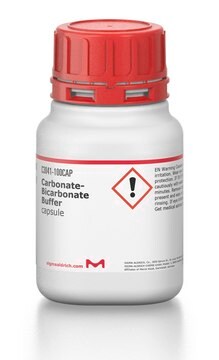1.06683
Potassium carbonate/sodium carbonate
GR for analysis
Synonyme(s) :
Potassium sodium carbonate
About This Item
Produits recommandés
Niveau de qualité
Forme
solid
pH
11.5 (20 °C, 50 g/L in H2O)
Densité
2.47 g/cm3 at 20 °C
Masse volumique apparente
1750 kg/m3
Température de stockage
2-30°C
Application
- Catalytic pyrolysis and in situ carbonization of walnut shells: This study highlights the use of potassium carbonate and sodium carbonate in the catalytic pyrolysis of walnut shells, demonstrating their potential to enhance the electrochemical performance of derived carbons. This process is pivotal in the development of energy storage materials and aligns with environmental sustainability goals (He W et al., 2024).
- Determination of barium sulfate in barite ore: This research utilizes potassium and sodium carbonate in a phase conversion-partial pressure-corrected headspace gas chromatography technique for the analysis of barite ore. This method underscores the importance of carbonate salts in mineral testing and environmental analysis, providing a reliable approach for the mining and environmental sectors (Fan ZY et al., 2022).
- Passive Fire Protection of Taeda pine Wood: This study examines the application of potassium carbonate and sodium carbonate in starch-based surface coatings for enhancing the fire resistance of Taeda pine wood. This application is critical in building material science and fire safety, showcasing the adaptability of carbonate salts in developing fire-retardant treatments (Tretsiakova-McNally S et al., 2021).
Remarque sur l'analyse
Phosphate and Silicate (as SiO₂): ≤ 0.005 %
Total sulfur (as SO₄): ≤ 0.005 %
Total nitrogen (N): ≤ 0.001 %
Heavy metals (as Pb): ≤ 0.002 %
Al (Aluminium): ≤ 0.001 %
Ca (Calcium): ≤ 0.005 %
Fe (Iron): ≤ 0.0005 %
Mg (Magnesium): ≤ 0.001 %
Loss on ignition (600 °C): ≤ 1.0 %
Mention d'avertissement
Danger
Mentions de danger
Classification des risques
Eye Dam. 1 - Skin Corr. 1 - STOT SE 3
Organes cibles
Respiratory system
Code de la classe de stockage
8B - Non-combustible, corrosive hazardous materials
Classe de danger pour l'eau (WGK)
WGK 1
Point d'éclair (°F)
Not applicable
Point d'éclair (°C)
Not applicable
Certificats d'analyse (COA)
Recherchez un Certificats d'analyse (COA) en saisissant le numéro de lot du produit. Les numéros de lot figurent sur l'étiquette du produit après les mots "Lot" ou "Batch".
Déjà en possession de ce produit ?
Retrouvez la documentation relative aux produits que vous avez récemment achetés dans la Bibliothèque de documents.
Les clients ont également consulté
Notre équipe de scientifiques dispose d'une expérience dans tous les secteurs de la recherche, notamment en sciences de la vie, science des matériaux, synthèse chimique, chromatographie, analyse et dans de nombreux autres domaines..
Contacter notre Service technique









